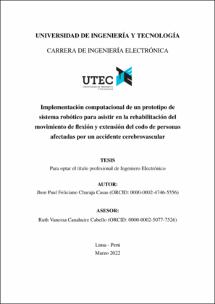| dc.contributor.advisor | Canahuire Cabello, Ruth Vanessa | |
| dc.contributor.author | Charaja Casas, Jhon Paul Feliciano | |
| dc.date.accessioned | 2022-04-25T17:31:37Z | |
| dc.date.available | 2022-04-25T17:31:37Z | |
| dc.date.issued | 2022 | |
| dc.identifier.citation | Charaja Casas, J. P. F. (2022). Implementación computacional de un prototipo de sistema robótico para asistir en la rehabilitación del movimiento de flexión y extensión del codo de personas afectadas por un accidente cerebrovascular [Tesis de Título Profesional, Universidad de Ingeniería y Tecnología]. Repositorio Institucional UTEC. https://hdl.handle.net/20.500.12815/275 | es_PE |
| dc.identifier.uri | https://hdl.handle.net/20.500.12815/275 | |
| dc.description.abstract | Las intensas terapias de rehabilitación motriz generan cansancio físico sobre el terapeuta y reducen la eficiencia de la terapia de rehabilitación. Por este motivo se han desarrollado sistemas robóticos que asisten en el proceso de rehabilitación. Estudios clínicos indican que las terapias asistidas con estos módulos robóticos logran mayor recuperación motriz que una terapia tradicional. El objetivo de este trabajo es implementar de forma computacional un prototipo de sistema robótico para asistir en la rehabilitación motriz de los movimientos de flexión y extensión del codo. El sistema robótico ofrece tres modos de funcionamiento y dos ejercicios de rehabilitación enfocados en la recuperación del control motriz de los movimientos del codo. Por último, el prototipo usa el robot UR5 de Universal Robots y una interfaz gráfica de usuario para configurar el ejercicio de rehabilitación. El sistema robótico de rehabilitación usa dos métodos de control de movimiento para su correcto funcionamiento. Por un lado, el control adaptativo permite mantener un adecuado seguimiento de trayectoria para valores diferentes de masa del brazo de cada paciente. Por otro lado, el control de impedancia garantiza mantener la interacción segura con el brazo del paciente. La implementación computacional del sistema robótico con los dos métodos de control se realizó en el simulador dinámico Gazebo. Finalmente, se usó el programa de modelado musculoesquelético AnyBody para verificar la activación muscular del brazo del paciente con los dos ejercicios de rehabilitación. | es_PE |
| dc.description.abstract | The intense motor rehabilitation therapies generate physical fatigue on therapist and reduce the efficiency of rehabilitation therapy. For this reason, robotic systems have been developed to assist in the rehabilitation process. Clinical studies indicate that therapies assisted with these robotic modules achieve greater motor recovery than traditional therapies. The objective of this work is to computationally implement a prototype of a robotic system to assist in the motor rehabilitation of flexion and extension movements of elbow. The robotic system offers three modes of operation and two rehabilitation exercises focused on the recovery of motor control of elbow movements. Finally, the prototype uses the UR5 robot from Universal Robots and a graphical user interface to configure the rehabilitation exercise. The robotic rehabilitation system uses two methods of movement control for its correct operation. On the one hand, adaptive control allow to maintain an adequate trajectory tracking for different values of arm mass of each patient. On the other hand, impedance control guarantee to maintain safe interaction with patient’s arm. The computational implementation of the robotic system with the two control methods has been done in Gazebo dynamic simulator. Finally, AnyBody musculoskeletal modeling program has been used to verify the muscular activation of the patient arm with the two rehabilitation exercises. | es_PE |
| dc.description.uri | Tesis | es_PE |
| dc.format | application/pdf | es_PE |
| dc.language.iso | spa | es_PE |
| dc.publisher | Universidad de Ingeniería y Tecnología | es_PE |
| dc.rights | info:eu-repo/semantics/openAccess | es_PE |
| dc.rights.uri | http://creativecommons.org/licenses/by-nc-nd/4.0/ | |
| dc.source | Repositorio Institucional UTEC | es_PE |
| dc.source | Universidad de Ingeniería y Tecnología - UTEC | es_PE |
| dc.subject | Rehabilitación | es_PE |
| dc.subject | Fisioterapia | es_PE |
| dc.subject | Dispositivo robótico | es_PE |
| dc.subject | Rehabilitación de Accidente Cerebrovascular | es_PE |
| dc.subject | Rehabilitation | es_PE |
| dc.subject | Stroke Rehabilitation | es_PE |
| dc.title | Implementación computacional de un prototipo de sistema robótico para asistir en la rehabilitación del movimiento de flexión y extensión del codo de personas afectadas por un accidente cerebrovascular | es_PE |
| dc.title.alternative | Computational implementation of a prototype robotic system to assist in the rehabilitation of the movement of flexion and extension of the elbow of people affected by a cerebrovascular accident | es_PE |
| dc.type | info:eu-repo/semantics/bachelorThesis | es_PE |
| dc.subject.ocde | https://purl.org/pe-repo/ocde/ford#2.02.01 | es_PE |
| dc.publisher.country | PE | es_PE |
| thesis.degree.discipline | Ingeniería Electrónica | es_PE |
| thesis.degree.grantor | Universidad de Ingeniería y Tecnología. Ingeniería Electrónica | es_PE |
| thesis.degree.level | Título profesional | es_PE |
| thesis.degree.name | Ingeniero Electrónico | es_PE |
| renati.advisor.dni | 42141373 | |
| renati.advisor.orcid | https://orcid.org/ 0000-0002-5077-7526 | es_PE |
| renati.author.dni | 75975743 | |
| renati.author.orcid | https://orcid.org/ 0000-0002-4746-5556 | es_PE |
| renati.discipline | 712026 | es_PE |
| renati.juror | Rojas Moreno, Arturo | |
| renati.juror | Valdivia Silva, Julio Ernesto | |
| renati.juror | Aranda Egúsquiza, Sergio | |
| renati.level | https://purl.org/pe-repo/renati/level#tituloProfesional | es_PE |
| renati.type | https://purl.org/pe-repo/renati/type#tesis | es_PE |


